Heinrich J.G., Aldinger F. (Eds.) Ceramic Materials and Components for Engines
Подождите немного. Документ загружается.

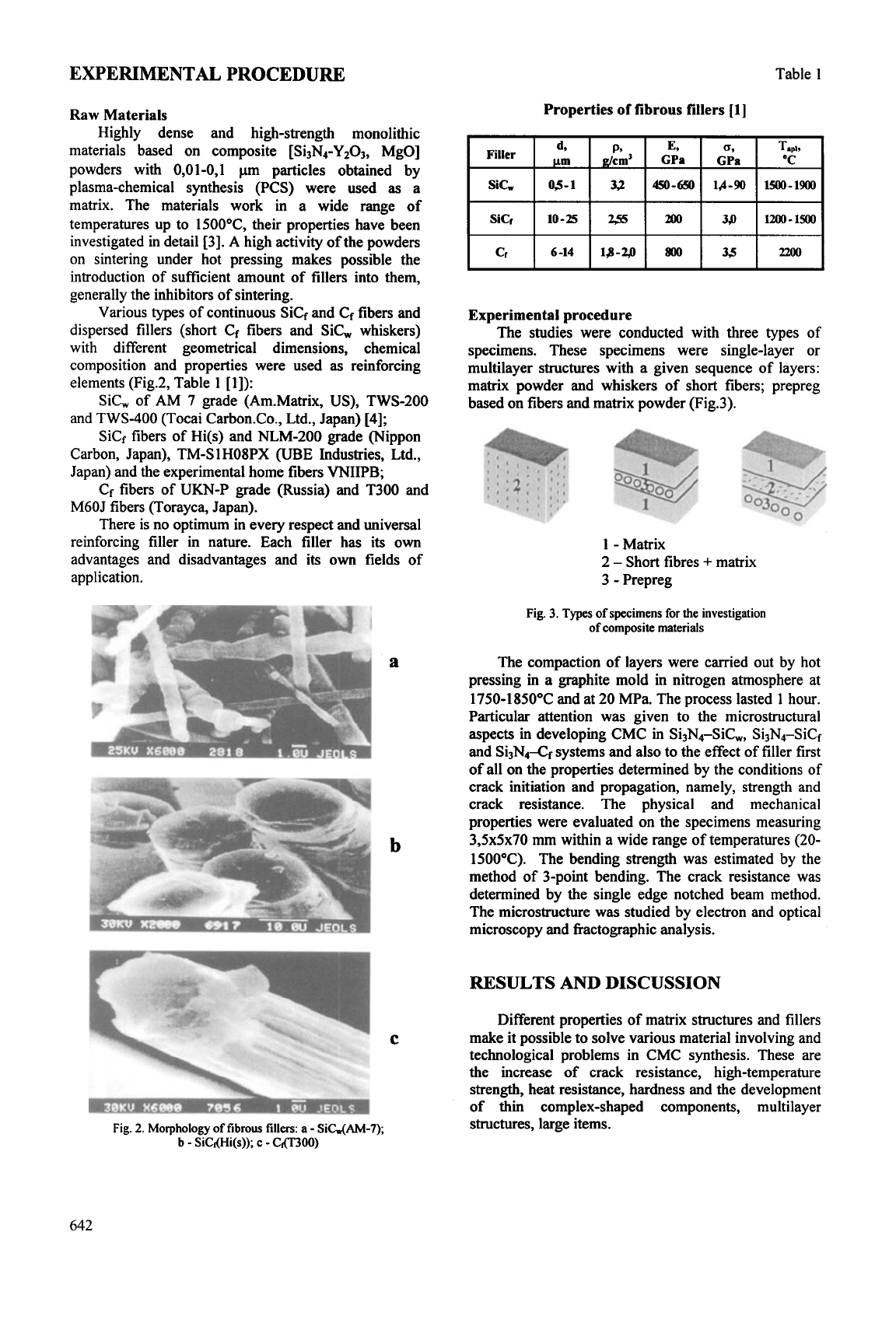
EXPERIMENTAL PROCEDURE
Table 1
Raw Materials
Highly dense and high-strength monolithic
materials based on composite [Si3N4-Y203, MgO]
powders with 0,Ol-0,l pm particles obtained by
plasma-chemical synthesis (PCS) were used
as
a
matrix. The materials work in a wide range
of
temperatures up to 15OO0C, their properties have been
investigated in detail [3].
A
high activity of the powders
on sintering under hot pressing makes possible the
introduction of sufficient amount of fillers into them,
generally the inhibitors of sintering.
Various types of continuous SiCf and Cf fibers and
dispersed fillers (short Cf fibers and Sic, whiskers)
with different geometrical dimensions, chemical
composition and properties were used
as
reinforcing
elements (Fig.2, Table
1
[
11):
Sic, of AM 7 grade (Am.Matrix, US), TWS-200
and
TWS-400
(Tocai Carbon.Co., Ltd., Japan) [4];
Sicf fibers
of
Hi@) and NLM-200 grade (Nippon
Carbon, Japan), TM-S 1 HOSPX
(UBE
Industries, Ltd.,
Japan) and the experimental home fibers
VNIIPB;
Cf fibers of UKN-P grade (Russia) and T300 and
M60J fibers (Torayca, Japan).
There is no optimum in every respect and universal
reinforcing filler in nature. Each filler has its
own
advantages and disadvantages and its
own
fields of
application.
Fig.
2.
Morphology of
fibrous
fillers: a
-
SiC4AM-7);
b
-
SiCr(Hi(s));
c
-
Cfl300)
Properties
of
fibrous fillers
[
11
C
I
I
I
I
I
Experimental procedure
The studies were conducted with three types of
specimens. These specimens were single-layer
or
multilayer structures with a given sequence of layers:
matrix powder and whiskers
of
short fibers; prepreg
based on fibers and matrix powder (Fig.3).
1
-
Matrix
2
-
Short fibres
+
matrix
3
-
Prepreg
Fig.
3.
Types of specimens for the investigation
of composite materials
a
The compaction
of
layers were carried out by hot
pressing in a graphite mold in nitrogen atmosphere at
1750-1850°C and at 20 MPa. The process lasted
1
hour.
Particular attention was given to the microstructural
aspects in developing CMC
in
Si3N4-SiC,, Si3N4-SiCf
and Si3N4-Cf systems and also to the effect
of
filler first
of
all on the properties determined by the conditions of
crack initiation and propagation, namely, strength and
crack resistance. The physical and mechanical
properties were evaluated on the specimens measuring
3,5x5x70 mm within a wide range of temperatures
(20-
1500°C). The bending strength was estimated by the
method of 3-point bending. The crack resistance was
determined by the single edge notched beam method.
The microstructure was studied by electron and optical
microscopy and fractographic analysis.
b
RESULTS AND DISCUSSION
Different properties
of
matrix structures and fillers
make it possible to solve various material involving and
technological problems in CMC synthesis. These are
the increase
of
crack resistance, high-temperature
strength, heat resistance, hardness and the development
of
thin complex-shaped components, multilayer
structures, large items.
C
642
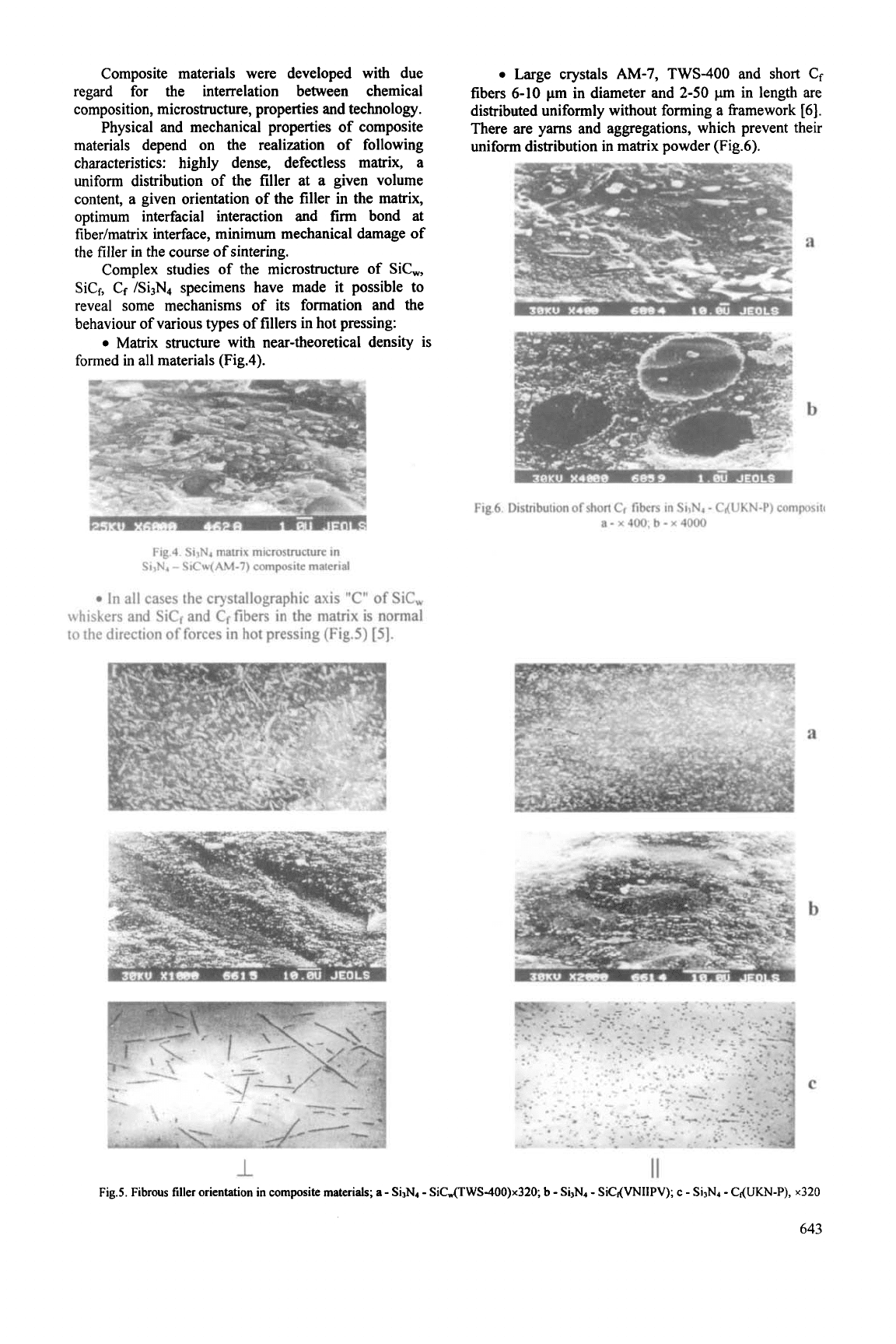
Composite materials were developed with due
regard for the interrelation between chemical
composition, microstructure, properties and technology.
Physical and mechanical properties of composite
materials depend on the realization of following
characteristics: highly dense, defectless matrix, a
uniform distribution of the filler at a given volume
content,
a
given orientation of the filler in the matrix,
optimum interfacial interaction and firm bond at
tibedmatrix interface, minimum mechanical damage of
the filler in the course of sintering.
Complex studies of the microstructure of Sic,,
Sicf, Cf /Si3N4 specimens have made it possible to
reveal some mechanisms of
its
formation and the
behaviour of various types of fillers in hot pressing:
formed in all materials (Fig.4).
0
Matrix structure with near-theoretical density is
0
Large crystals
AM-7,
TWS-400
and short Cf
fibers 6-10
pm
in diameter and
2-50
pm in length are
distributed uniformly without forming a framework [6].
There are
yams
and aggregations, which prevent their
uniform distribution in matrix powder (Fig.6).
Fig.6. Distribution
of
short
Cf fibers in SilNJ
-
CdUKN-P) composite;
a-
x
400; b
-
x
4000
Fig.4. Si3N4 matrix microstructure in
Si3NJ
-
SiCw(AM-7) composite material
0
In all cases the crystallographic axis "C" of Sic,
whiskers and SiCf and Cffibers in the matrix is normal
to
the direction of forces in hot pressing (Fig.5)
[5].
C
1.
II
Fig5 Fibrous filler orientation in composite
materials;
a
-
S&N4
-
SiCdTWS-400)~320; b
-
SIN4
-
SiCdVNIIPV);
c
-
SilN4
-
CdUKN-P),
x320
643
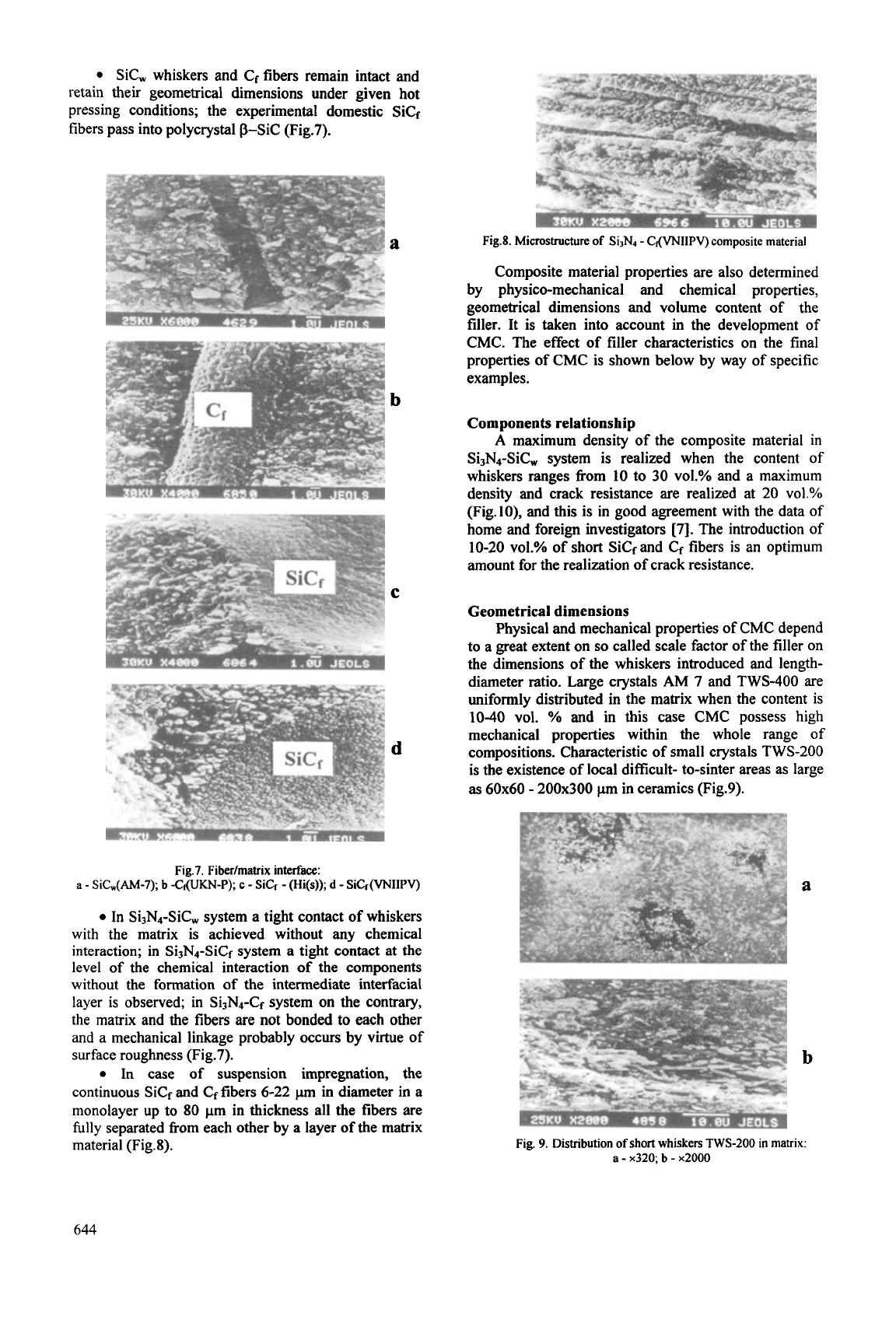
0
Sic, whiskers and Cf fibers remain intact and
retain their geometrical dimensions under given hot
pressing conditions; the experimental domestic SiCf
fibers pass into polycrystal p-Sic (Fig.7).
Fig.8. Microstructure
of
Si3N4
-
C1(VNlIPV) composite material
Composite material properties are also determined
by physico-mechanical and chemical properties,
geometrical dimensions and volume content of the
filler. It is taken into account
in
the development of
CMC. The effect of filler characteristics on the final
properties
of
CMC is shown below by way
of
specific
examples.
Fig.7. Fiberhatrix interface:
a
-
SiC,(AM-7);
b
CAUKN-P);
c
-
SiCr
-
(Hi($);
d
-
SiCr(VNI1PV)
0
In Si3N4-SiC, system a tight contact
of
whiskers
with the matrix is achieved without any chemical
interaction; in Si3N4-SiCf system a tight contact at the
level of the chemical interaction of the components
without the formation of the intermediate interfacial
layer is observed;
in
Si3N4-Cf system on the contrary,
the matrix and the fibers are not bonded to each other
and a mechanical linkage probably occurs by virtue of
surface roughness (Fig.7).
In case
of
suspension impregnation, the
continuous Sicf and Cffibers
6-22
pm in diameter in a
monolayer up to 80 pm in thickness all the fibers are
fblly
separated from each other by a layer of the matrix
material (Fig.8).
Components relationship
A
maximum density
of
the composite material
in
Si3N4-SiC, system
is
realized when the content of
whiskers ranges from 10 to
30
vol.% and a maximum
density and crack resistance are realized at
20
vol.%
(Fig.10), and this is
in
good agreement with the data of
home and foreign investigators [7]. The introduction of
10-20
vol.%
of
short SiCfand Cf fibers is an optimum
amount for the realization
of
crack resistance.
Geometrical dimensions
Physical and mechanical properties of CMC depend
to a great extent on
so
called scale factor of the filler on
the dimensions
of
the whiskers introduced and length-
diameter ratio. Large crystals
AM
7 and TWS-400 are
uniformly distributed in the matrix when the content is
10-40
vol.
YO
and
in
this case CMC possess high
mechanical properties within the whole range
of
compositions. Characteristic of small crystals TWS-200
is the existence of local difficult- to-sinter areas as large
as
60x60
-
200x300 pm in ceramics (Fig.9).
Fig.
9.
Distribution
of
short whiskers
TWS-200
in matrix:
a
-
x320;
b
-
x2000
644
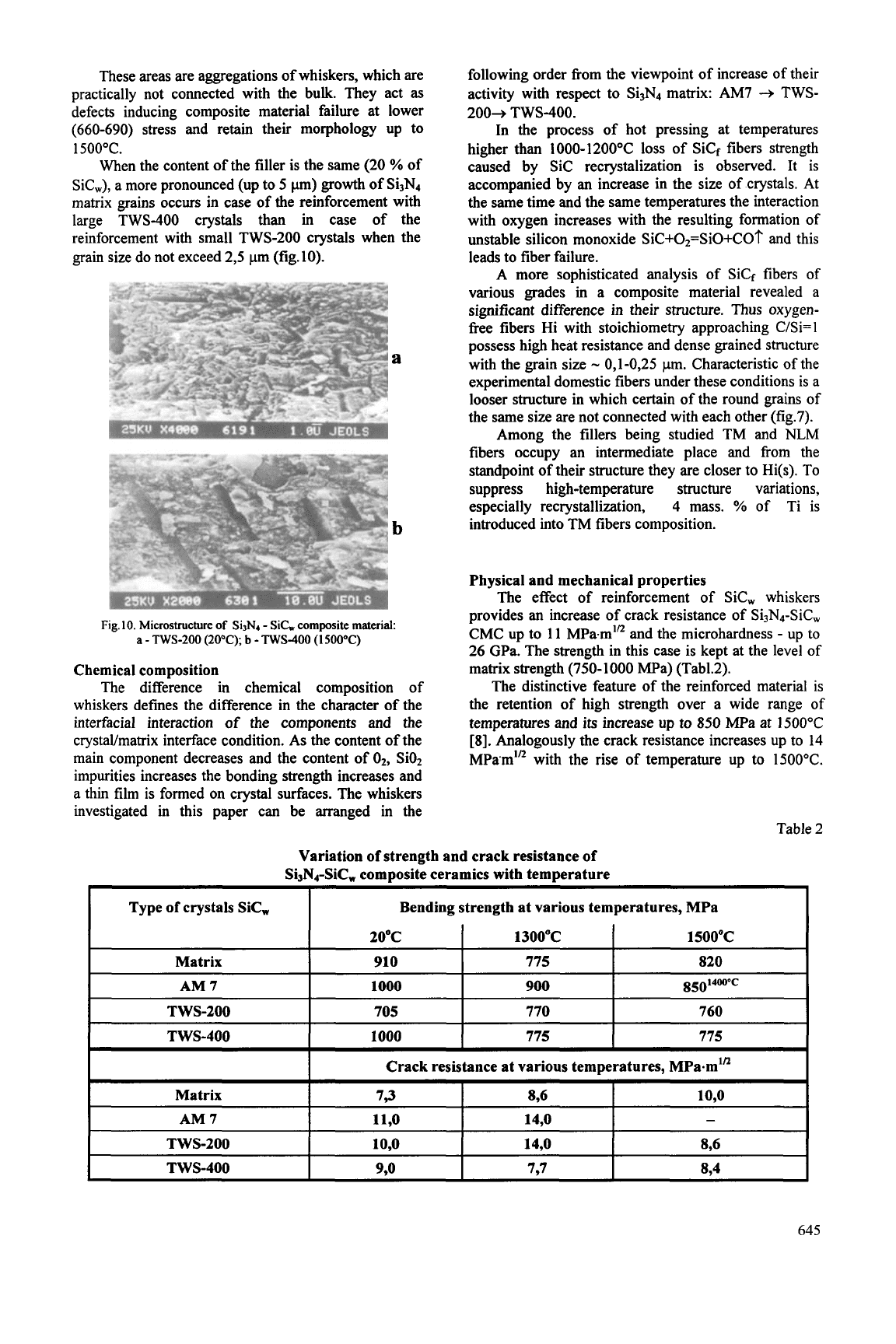
These areas are aggregations of whiskers, which are
practically not connected with the bulk. They act
as
defects inducing composite material failure at lower
(660-690) stress and retain their morphology up to
1500°C.
When the content of the filler is the same (20
YO
of
Sic,), a more pronounced (up to
5
pm) growth
of
Si3N4
matrix grains occurs in case of the reinforcement with
large TWS-400 crystals than
in
case
of
the
reinforcement with small TWS-200 crystals when the
grain size do not exceed 2,5 pm (fig.10).
Type
of
crystals Sic,
Matrix
AM 7
TWS-200
TWS-400
Fig.
10.
Microstructure
of
Si,",
-
SIC, composite material:
a
-
TWS-200
(20°C);
b
-
TWS-400
(1
SOOOC)
Chemical composition
The difference in chemical composition of
whiskers defines the difference in the character of the
interfacial interaction of the components and
the
crystaYmatrix interface condition. As the content of the
main component decreases and the content of
02,
Si02
impurities increases the bonding strength increases and
a thin film is formed on crystal surfaces. The whiskers
investigated in this paper can be arranged in the
Bending strength at various temperatures, MPa
2O0C 1300°C 1500°C
910 775 820
1000
900
8501400°c
705 770 760
1000
775 775
following order from the viewpoint of increase of their
activity with respect to Si3N4 matrix: AM7
+
TWS-
200+ TWS-400.
In the process of hot pressing at temperatures
higher than 1000-1200°C loss of SiCf fibers strength
caused by Sic recrystalization is observed. It is
accompanied by an increase in the size of crystals. At
the same time and the same temperatures the interaction
with oxygen increases with the resulting formation of
unstable silicon monoxide SiC+02=SiO+CO? and this
leads to fiber failure.
A more sophisticated analysis of SiCf fibers of
various grades in a composite material revealed a
significant difference in their structure. Thus oxygen-
free fibers Hi with stoichiometry approaching C/Si=
1
possess high heat resistance and dense grained structure
with the grain size
-
0,l-0,25
pm.
Characteristic of the
experimental domestic fibers under these conditions is a
looser structure in which certain of the round grains of
the same size are not connected with each other (fig.7).
Among the fillers being studied TM and
NLM
fibers occupy an intermediate place and
from
the
standpoint of their structure they are closer to Hi(s).
To
suppress high-temperature structure variations,
especially recrystallization, 4 mass.
YO
of Ti is
introduced into TM fibers composition.
~~
Matrix
AM 7
TWS-200
Physical and mechanical properties
The effect of reinforcement of Sic, whiskers
provides an increase of crack resistance of Si3N4-SiC,
CMC up to
11
MPamIn and the microhardness
-
up
to
26 GPa. The strength in this case is kept at the level of
matrix strength (750-1000 h4Pa) (Tabl.2).
The distinctive feature of the reinforced material is
the retention of high strength over a wide range
of
temperatures and its increase up to
850
MPa at 1500°C
[8].
Analogously the crack resistance increases up to
14
MPam'" with the rise of temperature up to 1500°C.
~
793 896
10,o
ll,o
14,O
-
10.0 14.0 8.6
Table
2
I
I
Crack resistance at various temperatures, MPadn
I
I
TWS-400
I
990
I
797
I
894
I

This is due to an optimum phase composition of
composite ceramics and such a microstructure, which
can be considered as the distribution of small grains of
P-Si3N4 between large crystals of p-Sic (fig.10).
The evaluation of physical and mechanical
properties of CMC shows that a maximum value of the
crack resistance
in
Si3N4-SiCf system is 8,2
in Si3N4-Cf system it is 9,s MPamln
as
compared to
matrix value equal to 6,6 MPa.mln.
In
both cases the
bending strength decreases by 10-20% and is 600-700
MPa. Such values of the strength are high enough for
these systems and they make it possible to increase
crack resistance at the expense of strength.
These results have been obtained using pure fibers,
which we consider as starting point. Thus the
tibedmatrix bond for Si3N4-SiCf is very firm and the
composite material becomes a brittle monolithic the
strength of which decreases. In Si3N4-Cf system, on the
contrary, the fiberlmatrix bond is weaker and the
material from being failed.
It should be expected that maximum values of
properties will be characteristic of combined laminated
specimens with short and continuous fibers (Fig.ll).
Fig.
1 1.
Microstructure.
of
combined laminated ceramics
with
short
and continuous
fibers
(Ct-UKN-P)
CONCLUSIONS
The potentialities of hot pressing have been
demonstrated in the development of high-temperature
composite materials reinforced with various dispersed
and fibrous in Sic,,,, SiCf, Cfl Si3N4 systems.
Simultaneous increase of strength and crack
resistance of composite materials is only possible in
case of using SIC, whiskers
as
the reinforcing filler
because they have the highest mechanical properties.
The use of such fibrous fillers as
Sicf and Cf offer
essential advantages for the increase of CMC crack
resistance with the decrease of strength by 1,5-2 times
as
compared to matrix level.
The materials developed can be used for
combustion chamber segments, rotor blades of gas-
turbine engines, cutting plates, etc.
REFERENCES
(1) S.M.Barinov, V.Ya.Shevchenko, Strenght of
engineering ceramics, Nauka, Moscow, (1996) 159.
(2) K.Nishio, K.I.Igashira, K.Take, Development of a
Combustor Liner Composed
of
Ceramic Matrix
Composite (CMC). Journal of Engineering for Gas
Turbines and Power, January, 121, (1999) 12-17.
(3)
I.Yu.Kelina, I.I.Tkacheva, A.V.Arakcheev,
N.I.Ershova, and V.P.Paranosenkov, Hot-pressed
constructional ceramic materials. Refractories, 3,
(4)
Keith R.Karasec Sic whisker characterization: an
update, Ceramic Bulletin, 70, [2], (1991) 224-228.
(5)
C.Olagnon, E.Bullock, Processing of high density
sintered Sic whisker reinforced Si3N4 composites.
Ceramics International. 17, (1991) 53-60.
(6) M.D.Sacks, H. W.Lee, O.E.Rojas, Suspension
processing of A1203/SiC whisker composites.
J.Amer.Ceram.Soc., 71,
[5],
(1989) 370-379.
(7) Jitendra P.Singh, Kenneth C.Goretta,
D.S.Kupperman, Fracture Toughness and strength of
SiC-whisker-reinforced Si3N4 Composites.
Advanced Ceramic Materials, 3,
[4],
(1988) 357-
360.
(8)Hiroya Ishizuka and Yoichi Saida, Fabrication of
Sic whisker reinforced Si3N4 ceramics turbine
nozzles by slip casting, Proceedings of the
International gas turbine congress, Kobe
(
1999) 29
1
-
296.
(1992) 28-30.
646
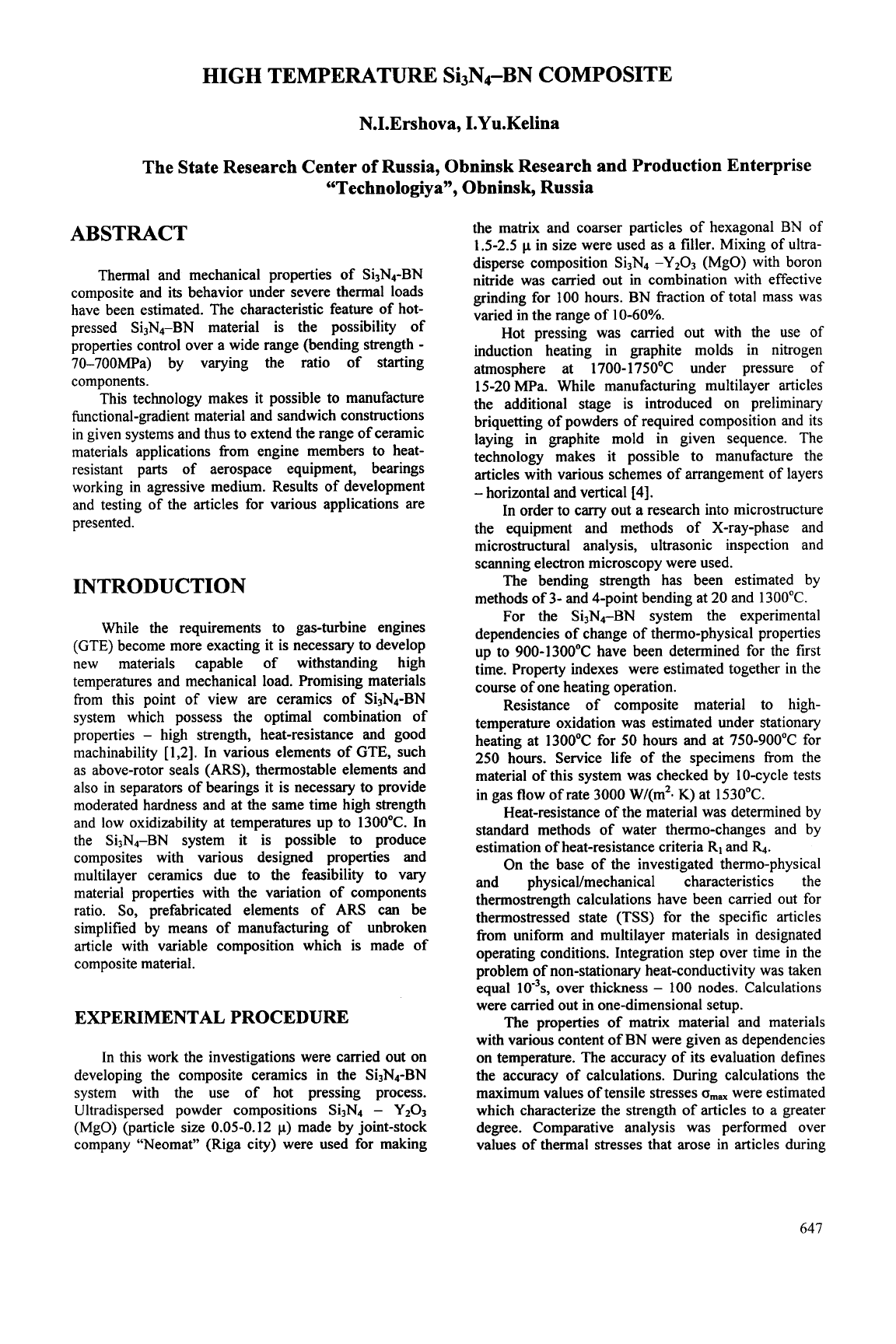
HIGH TEMPERATURE Si3N4-BN COMPOSITE
N.I.Ershova, 1.Yu.Kelina
The State Research Center
of
Russia,
Obninsk
Research and Production Enterprise
“Technologiya”,
Obninsk,
Russia
ABSTRACT
Thermal and mechanical properties of Si3N4-BN
composite and its behavior under severe thermal loads
have been estimated. The characteristic feature of hot-
pressed Si3N4-BN material is the possibility of
properties control over a wide range (bending strength
-
70-7OOMPa) by varying the ratio of starting
components.
This technology makes it possible to manufacture
functional-gradient material and sandwich constructions
in given systems and thus to extend the range of ceramic
materials applications from engine members to heat-
resistant parts of aerospace equipment, bearings
working in agressive medium. Results of development
and testing of the articles for various applications are
presented.
INTRODUCTION
While the requirements to gas-turbine engines
(GTE) become more exacting it is necessary to develop
new materials capable of withstanding high
temperatures and mechanical load. Promising materials
from this point of view are ceramics of Si3N4-BN
system which possess the optimal combination of
properties
-
high strength, heat-resistance and good
machinability [1,2]. In various elements of
GTE,
such
as above-rotor seals (ARS), thermostable elements and
also
in separators of bearings it is necessary to provide
moderated hardness and at the same time high strength
and low oxidizability at temperatures up to 1300OC. In
the Si3N4-BN system it is possible to produce
composites with various designed properties and
multilayer ceramics due to the feasibility to vary
material properties with the variation of components
ratio.
So,
prefabricated elements of ARS can be
simplified by means of manufacturing of unbroken
article with variable composition which is made of
composite material.
EXPERIMENTAL
PROCEDURE
In this work the investigations were carried out on
developing the composite ceramics in the Si3N4-BN
system with the use of hot pressing process.
Ultradispersed powder compositions Si3N4
-
Y203
(MgO) (particle size 0.05-0.12
p)
made by joint-stock
company “Neomat” (Riga city) were used for making
the matrix and coarser particles of hexagonal
BN
of
1.5-2.5
p
in size were used as a filler. Mixing of ultra-
disperse composition Si3N4
-Y203
(MgO) with boron
nitride was carried out in combination with effective
grinding for 100 hours. BN fraction of total mass was
varied in the range of 1
O-6O%.
Hot pressing was carried out with the use of
induction heating in graphite molds in nitrogen
atmosphere at 1700- 175OOC under pressure of
15-20 MPa. While manufacturing multilayer articles
the additional stage is introduced on preliminary
briquetting of powders of required composition and its
laying in graphite mold in given sequence. The
technology makes it possible to manufacture the
articles with various schemes of arrangement of layers
-horizontal and vertical
[4].
In order to cany out a research into microstructure
the equipment and methods of X-ray-phase and
microstructural analysis, ultrasonic inspection and
scanning electron microscopy were used.
The bending strength has been estimated by
methods of 3- and 4-point bending at 20 and 1300°C.
For
the Si3N4-BN system the experimental
dependencies of change of thermo-physical properties
up to 900-1300OC have been determined for the first
time. Property indexes were estimated together in the
course of one heating operation.
Resistance of composite material to high-
temperature oxidation was estimated under stationary
heating at 1300°C for
50
hours and at 750-900°C for
250 hours. Service life of the specimens fi-om the
material of this system was checked by 10-cycle tests
in gas flow of rate 3000 W/(m2.
K)
at 153OOC.
Heat-resistance of the material was determined by
standard methods of water thermo-changes and by
estimation of heat-resistance criteria
R,
and
%.
On the base of the investigated thermo-physical
and physicaYmechanica1 characteristics the
thermostrength calculations have been carried out for
thermostressed state
(TSS)
for the specific articles
from uniform and multilayer materials in designated
operating conditions. Integration step over time
in
the
problem of non-stationary heat-conductivity was taken
equal
lO-’s,
over thickness
-
100 nodes. Calculations
were carried out in one-dimensional setup.
The properties of matrix material and materials
with various content of BN were given as dependencies
on temperature. The accuracy of its evaluation defines
the accuracy of calculations. During calculations the
maximum values of tensile stresses
om=
were estimated
which characterize the strength of articles to a greater
degree. Comparative analysis was performed over
values of thermal stresses that arose in articles during
647
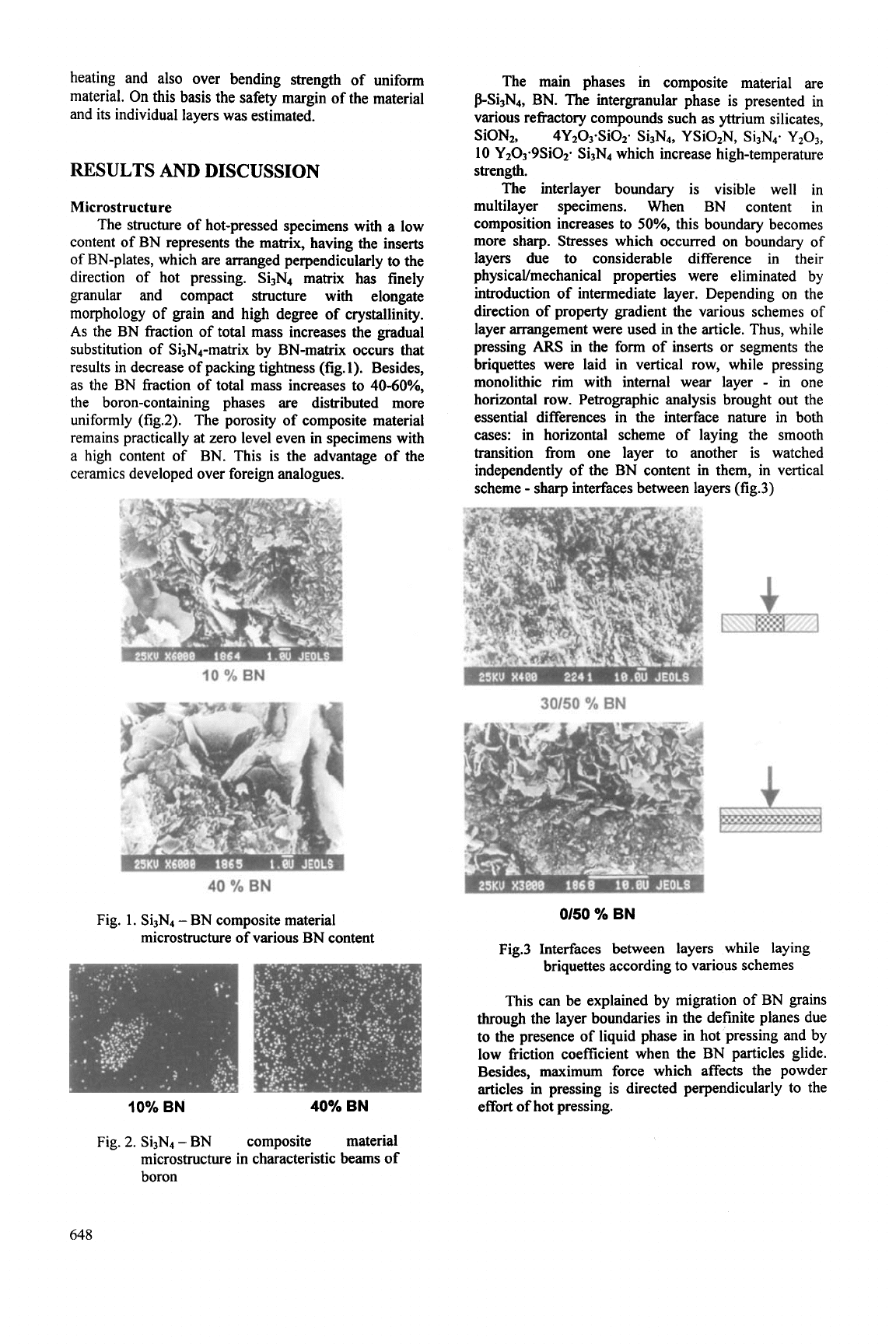
heating and also over bending strength of uniform
material.
On
this basis the safety margin of the material
and its individual layers was estimated.
RESULTS
AND
DISCUSSION
Microstructure
The structure of hot-pressed specimens with a low
content of BN represents the matrix, having the inserts
of BN-plates, which are arranged perpendicularly to the
direction of hot pressing. Si3N4 matrix has finely
granular and compact structure with elongate
morphology of grain and high degree of crystallinity.
As
the BN fraction of total mass increases the gradual
substitution of Si3N4-matrix by BN-matrix occurs that
results in decrease of packing tightness (fig.1). Besides,
as the BN fraction of total mass increases to
40-60%,
the boron-containing phases are distributed more
uniformly (fig.2). The porosity
of
composite material
remains practically at zero level even in specimens with
a high content of BN. This is the advantage of the
ceramics developed over foreign analogues.
The main phases in composite material are
kSi3N4, BN. The intergranular phase is presented in
various refractory compounds such as yttrium silicates,
SiON2, 4Y203.Si02- Si3N4, YSi02N, Si3N4. Y203,
10
Y203*9Si02. Si3N4 which increase high-temperature
strength.
The interlayer boundary is visible well in
multilayer specimens. When BN content in
composition increases to
50%,
this boundary becomes
more sharp. Stresses which occurred on boundary
of
layers due to considerable difference in their
physicaYmechanical properties were eliminated by
introduction of intermediate layer. Depending on the
direction
of
property gradient the various schemes of
layer arrangement were used in the article. Thus, while
pressing
ARS
in the form of inserts
or
segments the
briquettes were laid in vertical row, while pressing
monolithic rim with internal wear layer
-
in
one
horizontal row. Petrographic analysis brought out the
essential differences in the interface nature in both
cases: in horizontal scheme of laying the smooth
transition from one layer to another is watched
independently
of
the BN content in them, in vertical
scheme
-
sharp interfaces between layers
(fig.3)
10
%
BN
30150
%
BN
40
%
BN
Fig.
1.
Si3N4
-
BN composite material
microstructure of various BN content
10%
BN
40%
BN
0150
%
BN
Fig.3 Interfaces between layers
while laying
-
briquettes according to various schemes
This can be explained by migration of BN grains
through the layer boundaries in the definite planes due
to the presence of liquid phase in hot pressing and by
low friction coefficient when the BN particles glide.
Besides, maximum force which affects the powder
articles in pressing is directed perpendicularly to the
effort of hot pressing.
Fig.
2.
Si3N4
-
BN composite material
microstructure in characteristic beams
of
boron
648
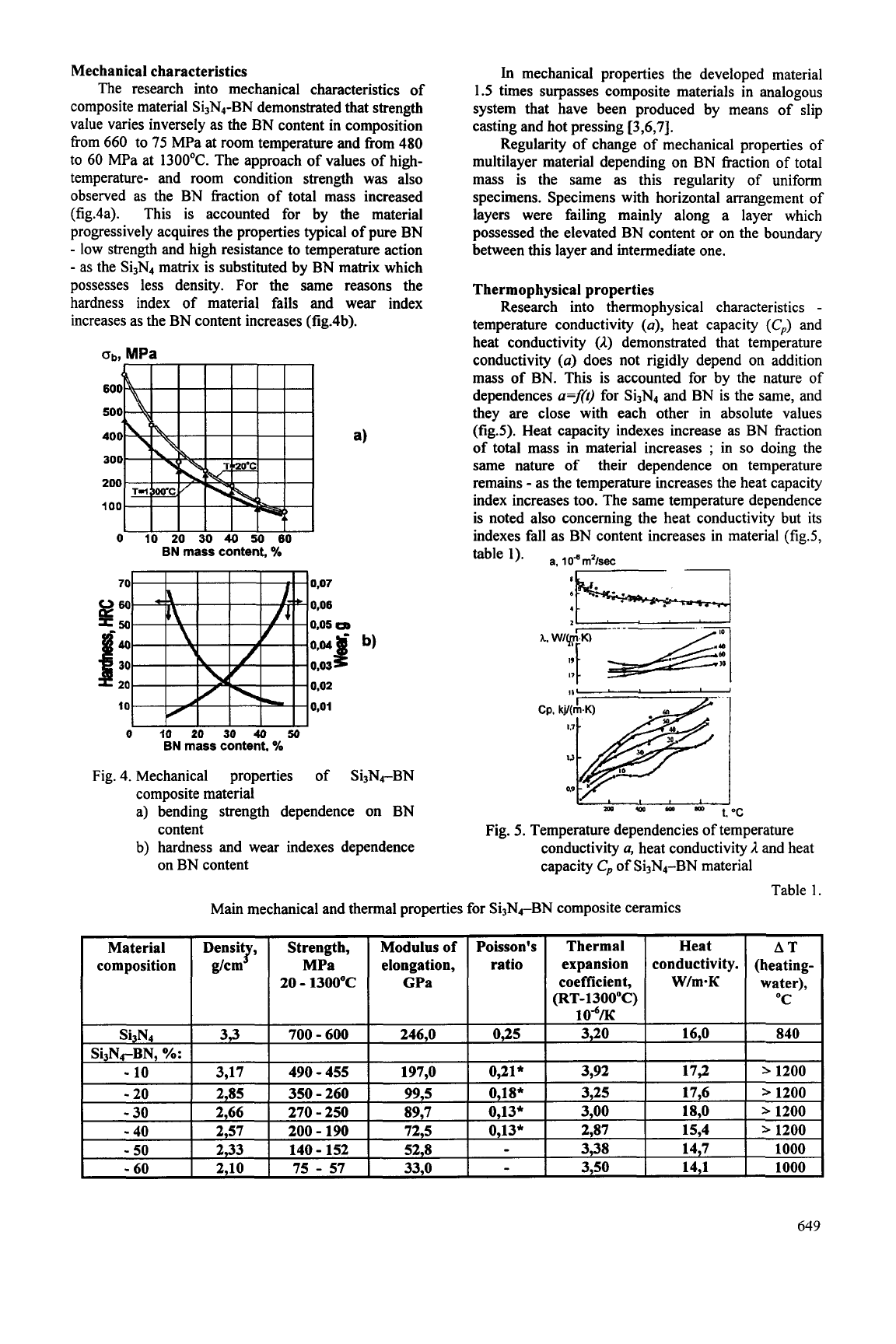
Mechanical characteristics
The research into mechanical characteristics of
composite material Si3N4-BN demonstrated that strength
value varies inversely as the BN content in composition
from
660
to
75
MPa at room temperature and from 480
to
60
MPa at
1300°C.
The approach of values of high-
temperature- and room condition strength was also
observed as the BN fraction of total mass increased
(figAa). This is accounted for by the material
progressively acquires the properties typical
of
pure BN
-
low strength and high resistance to temperature action
-
as the Si3N4 matrix is substituted by BN matrix which
possesses less density. For the same reasons the
hardness index of material falls and wear index
increases as the BN content increases (figAb).
(Jb.
MPa
~~ ~~
BN
mass
content,
./,
70
0.07
0,OB
0.05
CI)
OPM#
0.03
b'
g
20
0.02
10
0,Ol
BN
mass
content,
%
0
I0
20
30
40
50
Fig.
4.
Mechanical properties of Si3N4-BN
composite material
a) bending strength dependence on BN
b) hardness and wear indexes dependence
content
on BN content
In mechanical properties the developed material
1.5
times surpasses composite materials in analogous
system that have been produced by means of slip
casting and hot pressing
[3,6,7].
Regularity of change of mechanical properties of
multilayer material depending on BN fraction
of
total
mass is the same as this regularity
of
uniform
specimens. Specimens with horizontal arrangement of
layers were failing mainly along a layer which
possessed the elevated BN content
or
on the boundary
between this layer and intermediate one.
Thermophysical properties
Research into thennophysical characteristics
-
temperature conductivity
(a),
heat capacity
(C,)
and
heat conductivity
(A)
demonstrated that temperature
conductivity
(a)
does not rigidly depend on addition
mass
of
BN.
This
is accounted for by the nature
of
dependences
a=f((r)
for Si3N4 and BN is the same, and
they are close with each other in absolute values
(fig.5). Heat capacity indexes increase
as
BN fraction
of total mass in material increases
;
in
so
doing the
same nature of
their dependence on temperature
remains
-
as the temperature increases the heat capacity
index increases too. The same temperature dependence
is noted also concerning the heat conductivity but its
indexes fall as BN content increases in material
(fig.5,
Fig.
5.
Temperature dependencies of temperature
conductivity
u,
heat conductivity
1
and heat
capacity
C,
of
Si3N4-BN material
649
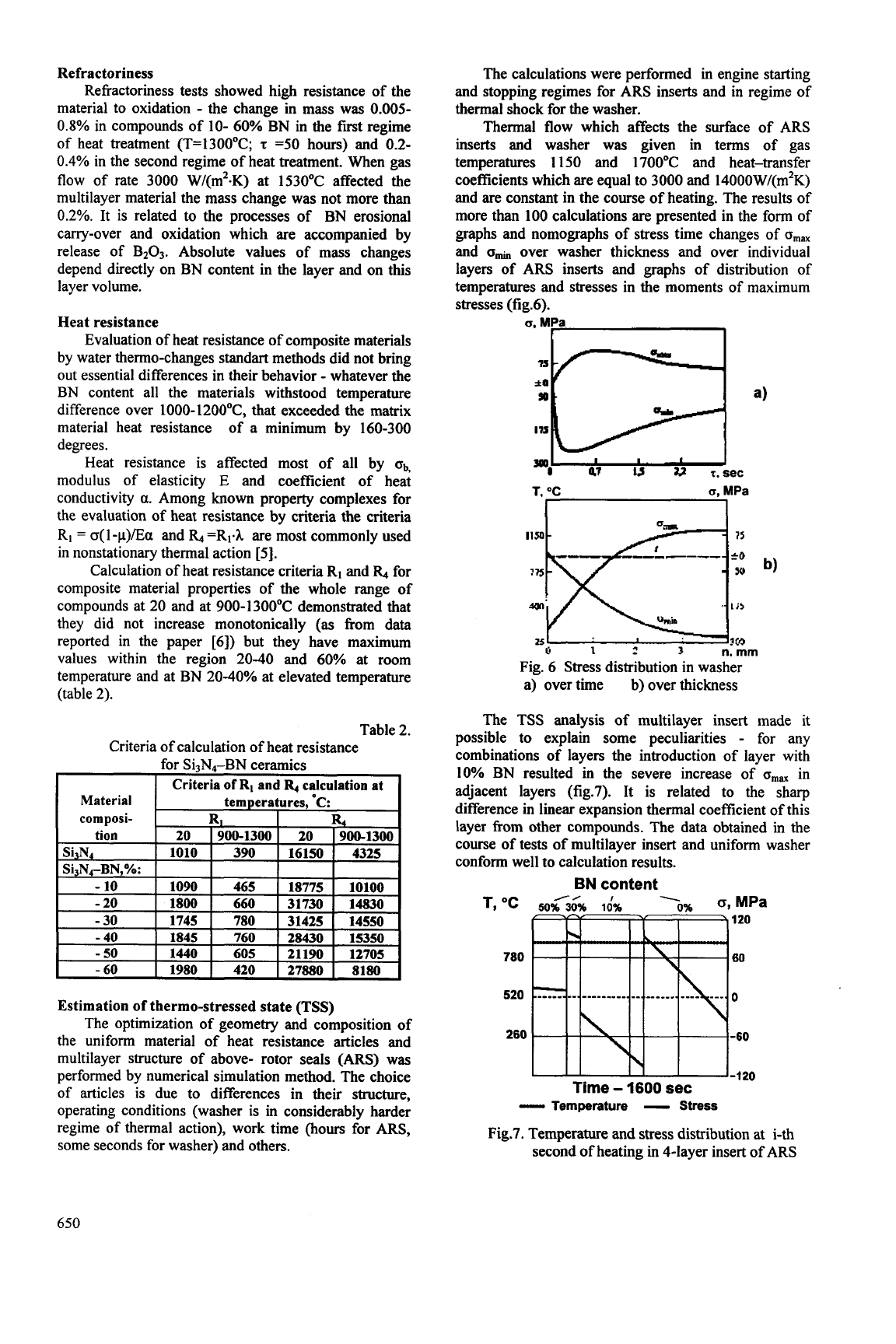
Refractoriness
Refractoriness tests showed high resistance of the
material to oxidation
-
the change in mass was
0.005-
0.8%
in compounds of
10- 60%
BN in the
fmt
regime
of heat treatment
(T=1300°C;
r
=50
hours) and 0.2-
0.4%
in the second regime of heat treatment. When gas
flow of rate
3000
W/(m2.K) at
1530°C
affected the
multilayer material the mass change was not more than
0.2%.
It is related to the processes of BN erosional
carry-over and oxidation which are accompanied by
release of Bz03. Absolute values of mass changes
depend directly on BN content in the layer and on this
layer volume.
Material
composi-
Heat resistance
Evaluation of heat resistance of composite materials
by water thermo-changes standart methods did not bring
out essential differences in their behavior
-
whatever the
BN content all the materials withstood temperature
difference over 1000-12OO0C, that exceeded the matrix
material heat resistance of a minimum by
160-300
degrees.
Heat resistance is affected most of all by
ab,
modulus of elasticity E and coefficient of heat
conductivity
a.
Among known property complexes for
the evaluation of heat resistance by criteria the criteria
R,
=
G(
1
-p)/Ea
and
&
=RIA are most commonly used
in nonstationary thermal action
[5].
Calculation of heat resistance criteria R1 and
&
for
composite material properties of the whole range of
compounds at 20 and at
900-1300°C
demonstrated that
they did not increase monotonically
(as
from data
reported in the paper
[6])
but they have maximum
values within the region 2040 and
60%
at room
temperature and at BN 2040% at elevated temperature
(table
2).
Criteria
of
R,
and
4
calculation at
temperatures,
'c:
R,
I
Rc
Estimation
of
thermo-stressed state
(TSS)
The optimization of geometry and composition of
the uniform material of heat resistance articles and
multilayer structure of above- rotor seals (ARS) was
performed by numerical simulation method. The choice
of articles is due to differences in their structure,
operating conditions (washer is in considerably harder
regime of thermal action), work time
(hours
for ARS,
some seconds for washer) and others.
The calculations were performed in engine starting
and stopping regimes for ARS inserts and in regime of
thermal shock for the washer.
Thermal flow which affects the surface of ARS
inserts and washer was given in terms of gas
temperatures
1150
and
1700°C
and heat-transfer
coefficients which are equal to
3000
and 14000W/(m2K)
and
are
constant in the course of heating. The results of
more than
100
calculations are presented in the form of
graphs and nomographs of stress time changes of
omax
and
0-
over washer thickness and over individual
layers of ARS inserts and graphs of distribution of
temperatures and stresses in the moments of maximum
stresses
(fig.6).
Q.
MPa
I
Fig.
6
Stress distribution in washer
a) over time b) over thickness
The TSS analysis of multilayer insert made it
possible to explain some peculiarities
-
for any
combinations of layers the introduction of layer with
10%
BN resulted in the severe increase of
om=
in
adjacent layers (fig.7). It is related to the sharp
difference in linear expansion thermal coefficient of this
layer from other compounds. The data obtained in the
course of tests
of
multilayer insert and uniform washer
conform well to calculation results.
BN
content
\
T,
"C
SO%<<%
Id%
0%
us
MPa
120
780
60
520
0
260
-60
-120
Time
-
1600
sec
-
Temperature
-
Stress
Fig.7. Temperature and stress distribution at i-th
second of heating in 4-layer insert of ARS
650
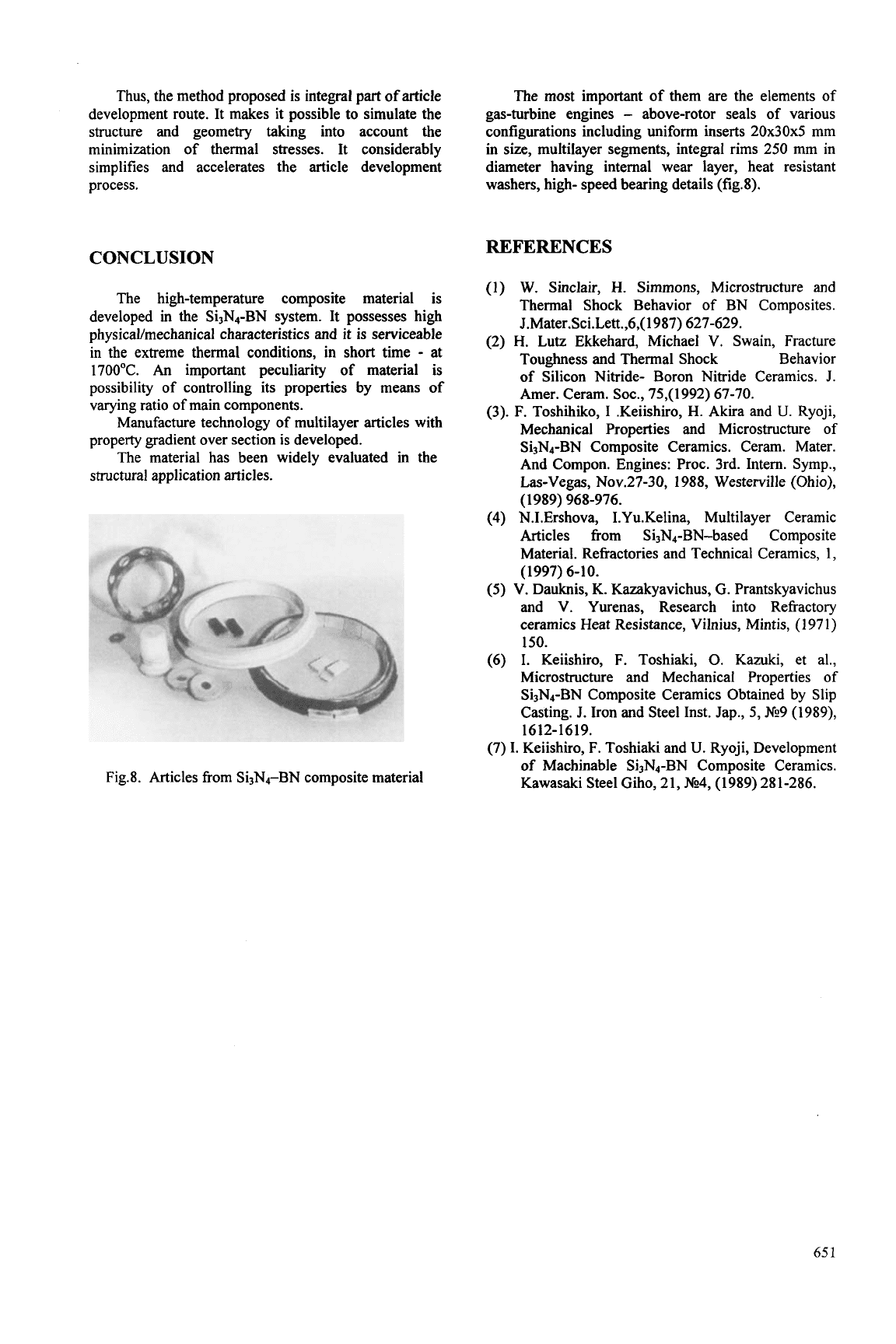
Thus, the method proposed is integral part
of
article
development route. It makes it possible to simulate the
structure and geometry taking into account the
minimization of thermal stresses. It considerably
simplifies and accelerates the article development
process.
CONCLUSION
The high-temperature composite material is
developed in the Si3N4-BN system. It possesses high
physicaVmechanica1 characteristics and it is serviceable
in the extreme thermal conditions, in short time
-
at
1700OC.
An
important peculiarity of material is
possibility of controlling its properties by means of
varying ratio of main components.
Manufacture technology of multilayer articles with
property gradient over section is developed.
The material has been widely evaluated in the
structural application articles.
Fig.8. Articles from Si3N4-BN composite material
The most important of them are the elements
of
gas-turbine engines
-
above-rotor seals of various
configurations including uniform inserts 20x30~5 mm
in size, multilayer segments, integral rims 250 mm in
diameter having internal wear layer, heat resistant
washers, high- speed bearing details (fig.8).
REFERENCES
(1)
W.
Sinclair, H. Simmons, Microstructure and
Thermal Shock Behavior of BN Composites.
J.Mater.Sci.Lett.,6,( 1987) 627-629.
(2) H. Lutz Ekkehard, Michael
V.
Swain, Fracture
Toughness and Thermal Shock Behavior
of Silicon Nitride- Boron Nitride Ceramics.
J.
Amer. Ceram. SOC., 75,(1992) 67-70.
(3).
F.
Toshihiko,
I
.Keiishiro,
H.
Akira and
U.
Ryoji,
Mechanical Properties and Microstructure of
Si3N4-BN Composite Ceramics. Ceram. Mater.
And Compon. Engines: Proc. 3rd. Intern. Symp.,
Las-Vegas, Nov.27-30, 1988, Westerville (Ohio),
(4)
N.I.Ershova, I.Yu.Kelina, Multilayer Ceramic
Articles from Si3N4-BN-based Composite
Material. Refractories and Technical Ceramics, 1,
(5)
V. Dauknis, K. Kazakyavichus, G. Prantskyavichus
and V. Yurenas, Research into Refractory
ceramics Heat Resistance, Vilnius, Mintis,
(1
97
1)
150.
(6)
I.
Keiishiro,
F.
Toshiaki,
0.
Kazuki, et al.,
Microstructure and Mechanical Properties of
Si3N4-BN Composite Ceramics Obtained by Slip
Casting.
J.
Iron and Steel Inst. Jap.,
5,
N29 (1989),
(7)
I.
Keiishiro,
F.
Toshiaki and
U.
Ryoji, Development
of Machinable Si3N4-BN Composite Ceramics.
Kawasaki Steel Giho, 21,
N24,
(1989) 281-286.
(1989) 968-976.
(1997) 6-10.
1612-1619.
65
1
